Indian Accent : Restaurant Review
Rating : 3.75 stars out of 5 (Close to Excellent)
Delhi, India
Visited in October 2015
Presented as a Part I + Part II Review.
Part I
Modernist Indian restaurant cuisine , which took root overseas before gaining bite on native earth, still has very few excellent practitioners of it in India. Mumbai's Masala Library practises a clumsy transplanted version of it , and disappointed me a lot on my Mumbai trip while Bangalore's Pink Poppadum had kindly organized a 9 course affair which gained my polite admiration but not my palatal ecstasy. But Delhi's Indian Accent has managed to consistently win international plaudits while its Chef - Manish Merhotra - has garnered acclaim from patrons to critics to television shows, with Bangalore T.O.I reviewer Suresh Hinduja Esquire even declaring Mehrotra a "genius". With forty-five covers, and often feeding up to hundred diners per night over two sittings per evening, Indian Accent , from its food alone, can rack up the profits to keep its owners happy - never mind that many top degustation restaurants the world over would frown upon the logistics and quality control of two sittings per evening. To experience this Delhi phenomenon, I booked two lunch reservations on successive days and awaited the potentially outstanding restaurant experience that has eluded me in India.
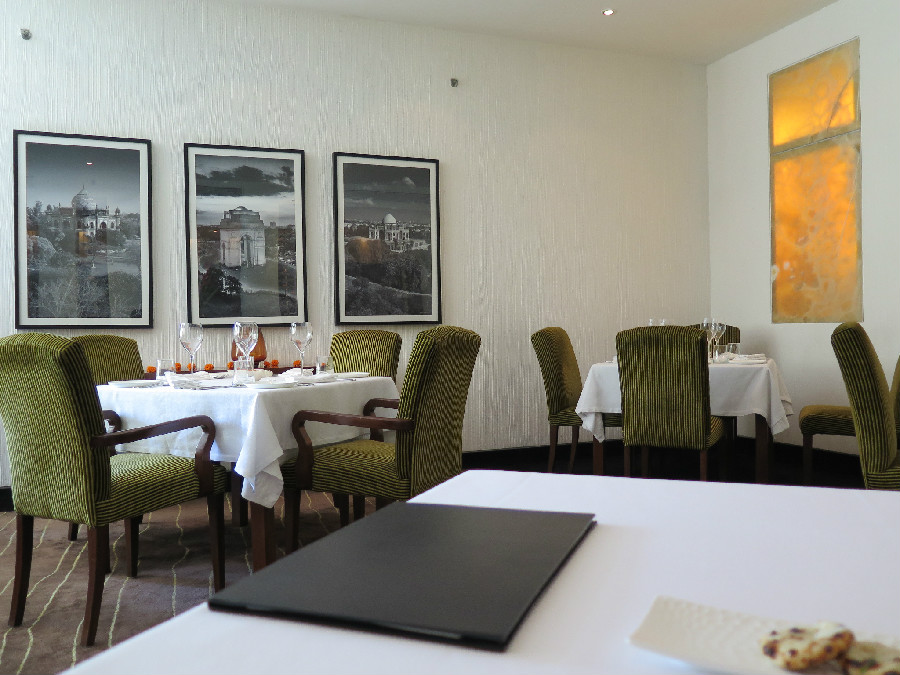
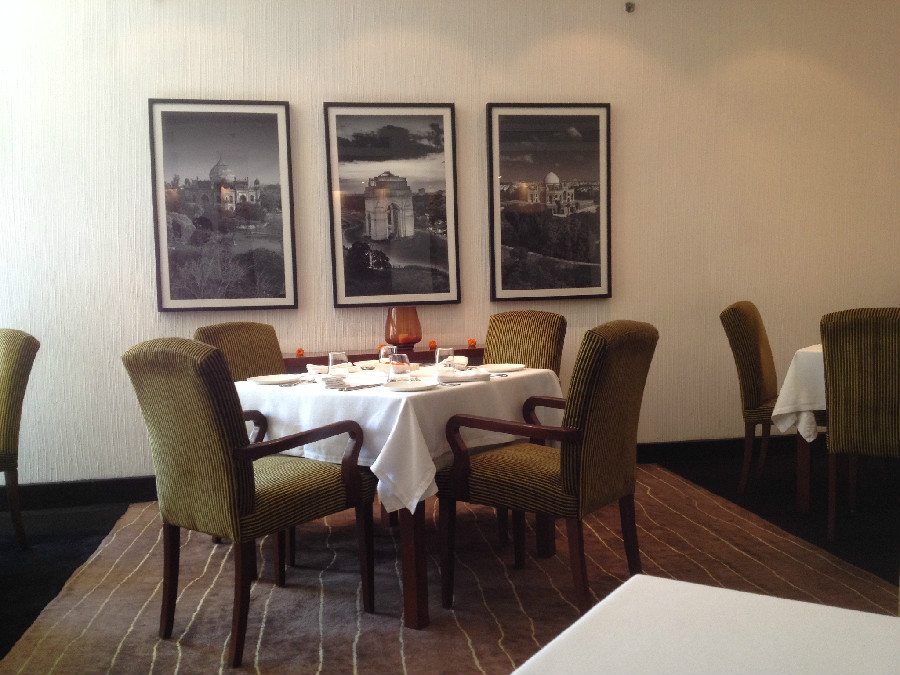
A pleasant atmosphere of standard-issue formal dining, without the Le Louis XV grandeur ,greets you in rooms of compact size. That's not necessarily a disappointment but the sense of quietly pleasurable occasion can be brutally ruptured by a noisy uncouth and boisterous group of dozen from an adjoining table who have all the money in the world but have very little of what money does not guarantee - decorum. This is ,again, not necessarily another damnation issued upon the already much-pilloried Delhite because I've witnessed similar lack of manners and consideration towards fellow diners in some elite restaurants in the Western world too.
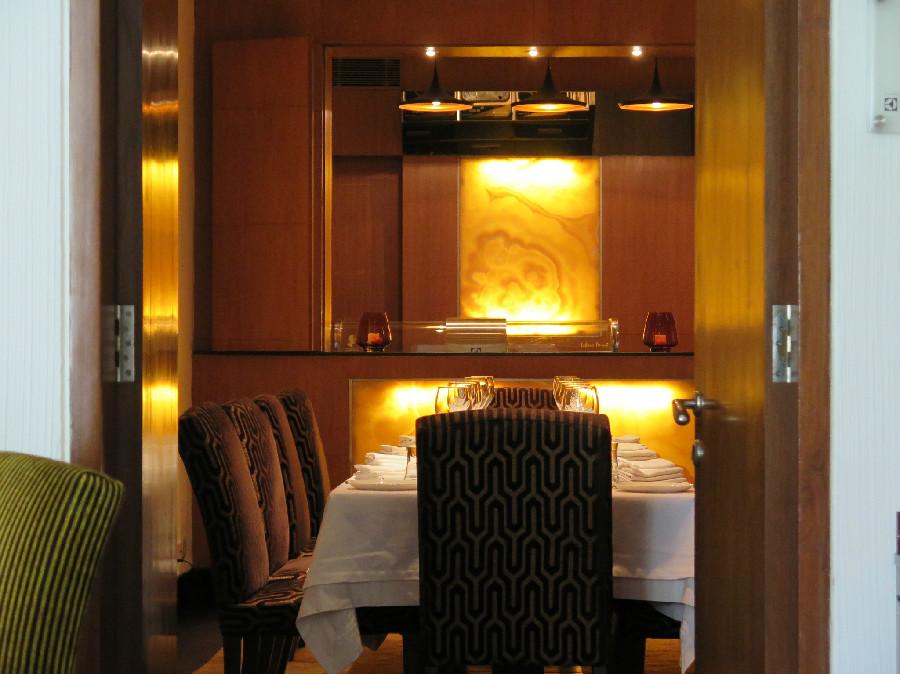
The amuse bouche which blows you away with its taste is very rarely cooked by chefs in India and Australasia. Indian Accent did not hit this opening ball sixer, but among all its offerings, a beautifully balanced pumpkin and coconut soup ably massaged my cockles. I am puzzled that a chef of Mehrotra's caliber does not realize the blue cheese in his mini-naans smothers the taste of everything else.
The much-publicized potato sphere with white pea ragda then appears : the first component is a smart engineering feat where tiny threads of the delicious lime-flavoured potato bhujia (a fried flour snack) is spun into a whole ball - but it's not exactly lashed by the topping sauces. What I mean is that the latter add up to too sweet an effect. Mehrotra had turned the standard archiecture - a semi-solid saucy concoction blanketed by millimeters-long bits of crispy sev - inside out. But Indian street-snacks score their triumphs by impacting your tongue with lasciviously sublime flavours - whereas the version here cloys with its timid dulcet notes. Such gripes were forgotten when I experienced the duck khurchan cornetto - the exquisitely cooked and flavoured duck meat reminded me of uber-class butter chicken. Associate Chef Vivek Rana was surprised to hear me say that, but what I was alluding to, was the same slow-cooked, complex , haunting richness of cream-cooked meat that blew me away when I experienced this duck rendition. The next day's chicken khurchan did not achieve similar depth.
Indian Accent's service staff - comprised mostly of young gentlemen - will assiduously help you. Catching their eye is not difficult , and early in my first meal when I was the only patron in the restaurant, the staff went so far as to ease my chair in when I would begin to assume my seat, and draw the chair out when I had to leave the table. Of course, these pampering niceties take a back-seat as the restaurant fills up. But do not expect your service staff here to be the world's best and most sophisticated - becoming so will require more demanding selection, training and frills.
In Meeta Achar Spare Ribs, the technical part of ensuing soft rib meat was admirably accomplished but the flavouring lacked punch - the sweet-pickle was not much different from the barbecure sauce this cut of meat is usually saddled with. A year earlier - I'd eaten a bolder version in Auckland's Cassia by Siddarth Sahrawat where a whole hunk of fried duck had been parked atop an Indian-style pickle sauce the tempered kick of which was additionally leavened by lychees and cashews.
Bacon-coated coated Prawns in wasabi were moreish no doubt, but I've had higher quality prawns than this in India (a spectacular Gambas Piccante from the mercurial Olive Beach, B'lore in 2010) and while this is fashionable and tasty bar food, it will not, especially when the plate has no additional componnets, get my vote in an ambitious nouvelle cuisine restaurant .
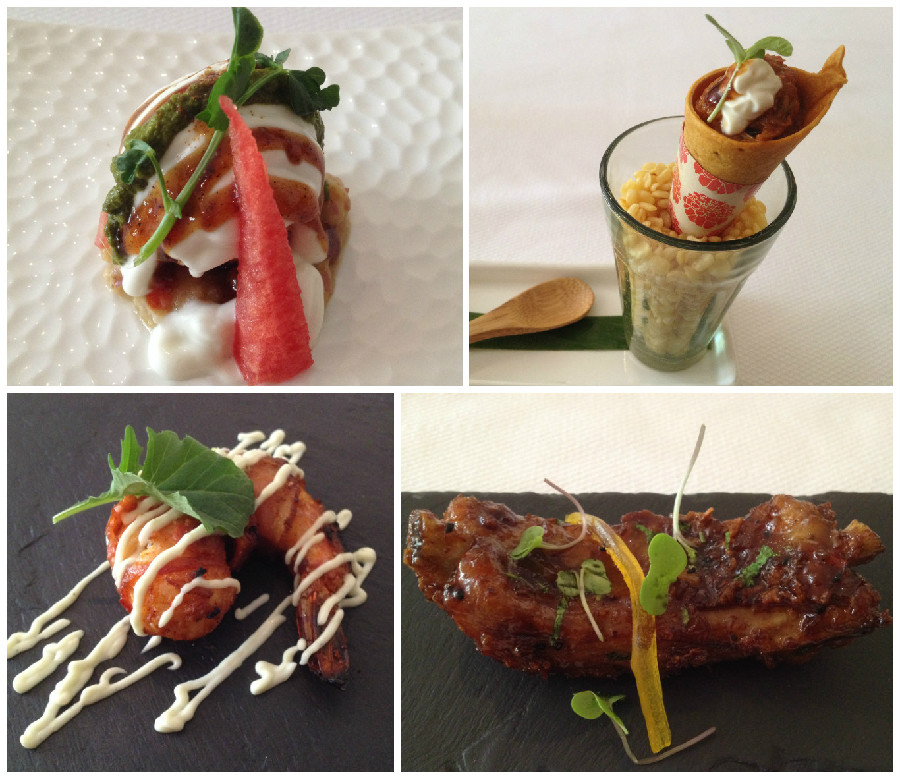
It follows that what had begun to disappoint me was the relative simplicity of many of these "one-component" renditions, with a progressively felt paucity of elaborate compositions (that still remain delicious) which great restaurants artistically engineer. The pace of the meal was slightly approximate to that of a sushi-and-sashimi omakase (the slower US versions , not the express Tokyo 22 minute whirlwinds) and the compositions were similarly uncomplicated. The duck, prawn, and pork were all "dishes" you might find in a high-quality gastro pub - but this complaint was mitigated to some extent by the main course - what it gained in numerical elements, it lost in deliciousness compared to its predecessors. The rough template was "fish moilee" - and the plate of this main course (selected by me over the chicken main course to see what a Northerner could do with fish) feautured two parallel fillets of tamarind-coated fish in a yellow sea of quinoa. The fried cashews on the plate did very little, and the fish - soft but with barely any flavour - when consumed with the creamy faintly tart notes of the quiona-studded yellow sauce (not very different from a bearnaise) synthesized no special symphony. This was the make or break part of that promising afternoon - the tipping point.
I struggled to detect any taste of foie gras in the separately requested Foie Gras Galouti Kebab. The kebab was a faithful but unspectacular rendition of the ultra-smooth creamy subtly spiced pounded kebabs you get in select Indian establishments (I had tasted a superb version in the briefly lived Tunday kababi in B'lore). It was served with a lightly acidic strawberry green chilli chutney, but there was wasn't much deliriously heady fattiness in the kebab to cut anyway. You could no doubt taste the woodsmoky sweetness of the protein inside the Applewood-smoked-bacon-stuffed kulcha but it packed no special depth of taste. "Black dairy" dal was enjoyable - its lentil heft pleasantly enhanced by a "cream of tomato" effect.
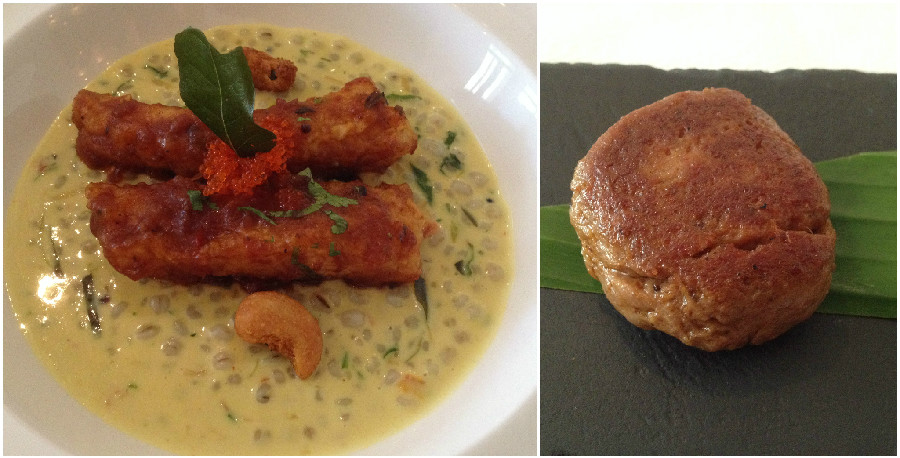
Mahatma Gandhi continues his bevolence even posthumously. It was a "dry day" for the country (October 2nd) and I was spared the steep bill of alcohol but what was not so fortunate was that it was a dry day for the hotel's laundry too! - there was no staff to do the laundry that day. I placated myself with the excellent comforts and aesthetics of my room which had been upgraded for free, by the kind management. The next day I tasted the "Marigold" cocktail which uses rum, orange and pineapple but it didn't hold a candle to the spectacular "Quay Butterfly" I enjoyed in Sydney's Quay last year.
Dessert in that afternoon's degustation lacked ambition. There were three elements on the plate : vanilla ice cream , a doda burfi treacle tart ( "doda burfi" is a fudge-like creation of condensed milk, wheat et al) and custard-apple cream (its good to get a distillate from a fruit I've never encountered in western countries).Tasted separately none of these individual components impressed - but tasted together with the coolness of ice cream and sweet light currents swirling through the heaviness of the tart, this blended dessert slides down the throat much easier.
The bill, for one mocktail and all of the above food (8 course degustation and a separately requested appetizer) added up to a reasonable Rs.4200.
Associate chef Vivek Rana voluntarily came out to converse and make sure that I was satisfied. On my request, The Man Himself : Manish Mehrotra came out to my table and was his genial gracious self as I heaped hosannas on him for furthering the cause of Indian nouvelle cuisine. Upon learning that I had rerouted from my Auckland-to-Bangalore-'n'-return usual circuit to include Delhi this time exclusively to experience the putative peaks of Indian Accent (although I admit that later, I shoved an Orient Express dinner in this 36 hour time slot) , he instantaneously advised me to abandon my a la carte plans for the next afternoon as he had just then conceived a plan to ask his associates to devise an entirely different tasting menu for me - not present on the restaurant's actual menu - the next day! The food notwithstanding, this gives me renewed hope in the largesse of these gentlemen from the hospitality industry.
Manish Mehrotra (R) with UPN (L)
Part II : The Next Afternoon (you may return after a break)
You go to the fanciest restaurants in the world, but you slowly realize that unless the food per se has smashing flavour ,all the faff and frills count for naught. In Indian Accent, similar thoughts had begun to assail me just before the John Dory from Australia ,baked in Amritsari masala butter, met my tongue. It had such a haunting delicacy of flavour and was so exquisitely soft, that when I closed my eyes while enjoying it , the experience simulated the pleasure oasis of canoodling with my lover.
Laudably, Merhotra is a keen actively participating tourist in culinary India - jetting (or busing) from Amritsar to Chennai to Goa. I was particularly impressed by by how he smartly recruited flavour profiles of the Konkan Coast to make fried soft shell crab (not much seen in Indian restaurants till recently) mixed with thin cuts of flame-grilled coconut and chives, well accessorized with a creamy tomato-pickle-sauce.
I can't remember the last time I ate a savoury dish in which fruit was was the main component . Here, Pomelo (similar to grapefruit) was given the Indian street-food treatment by being bathed in a gently zingy masala liquid perked up by crispy garlic - 'twas a notable departure but not a take-off onto tweaked heaven.
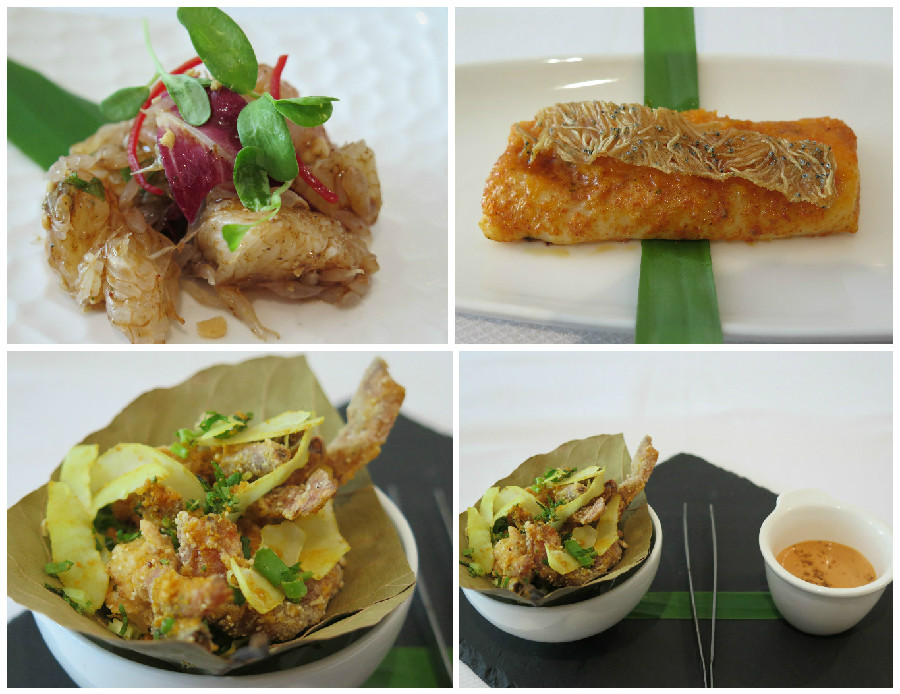
Manager Paalkhi - a young lady with winsome sweetness in demeanour - politely ensured that I was comfortable and enquired whether I had slept well. Comfort graded into excitement and high curiousity when I saw the a la carte menu feature a "Paper Dosai" with drastically different accoutrements. On tasting the Dosai (I like the Tamil-inflected addition here of 'i' at the Dosa!) ,one notes that the cone of paper dosa is admirably executed with paper-thin texture and crispiness - and the point of the dish was to substitute the usual potato masala with a mushroom-'n'-chestnut mix. The chestnut had a wonderful through-and-through crunch across its body , otherwise there wasn't much excitement or innovation in a dish from which I had expected more technical and flavour-spinning stunts. The 63 degree egg curry , which they kindly put onto this specially created tasting menu for me on request just like the previous dish, was a bigger dappointment - there was an immaculately poached egg (the so-called 63 degree treatment which perfectly renders this soft oozy version) in the centre but the curry around was a pedestrian version of densely flavoured chicken curry. Neither having the '63 egg' on a separate part of the spoon from the chopped chicken masala, nor mixing them all thoroughly , generated any special pleasure.
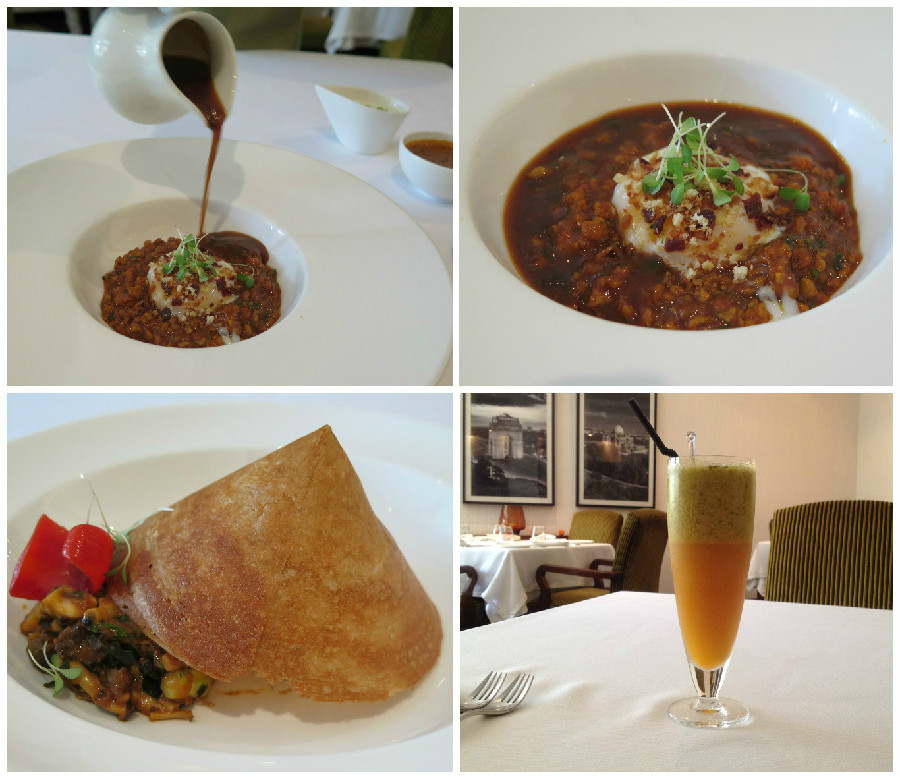
"Daulat ki Chaat" - now this is what we call a grand ending! Cold white smoke welled up and flowed outside from within the vessel, and the bowl held nine splayed 100 rupee notes (clearly designed to be a jocular replica) below which a beautiful amorphous dessert nestled. Whipped cream was beautifully flavoured and perfumed - rose, saffron, pistachios and almonds all added to the exquisite scented taste. It had a wonderfully light feel with none of the heaviness you suspect on seeing it. Though my stomach was already heavy, I finished this entire serving - so fine this concoction was. Stunts continued with blue flames rising from flambeed 70% valrhona chocolate Old Monk rum-ball - a shapely spheroid of glistening dark colour. It looked better than it tasted. The rum, whatever little there was of it, did not kick you, and the chocolate did not kill you.
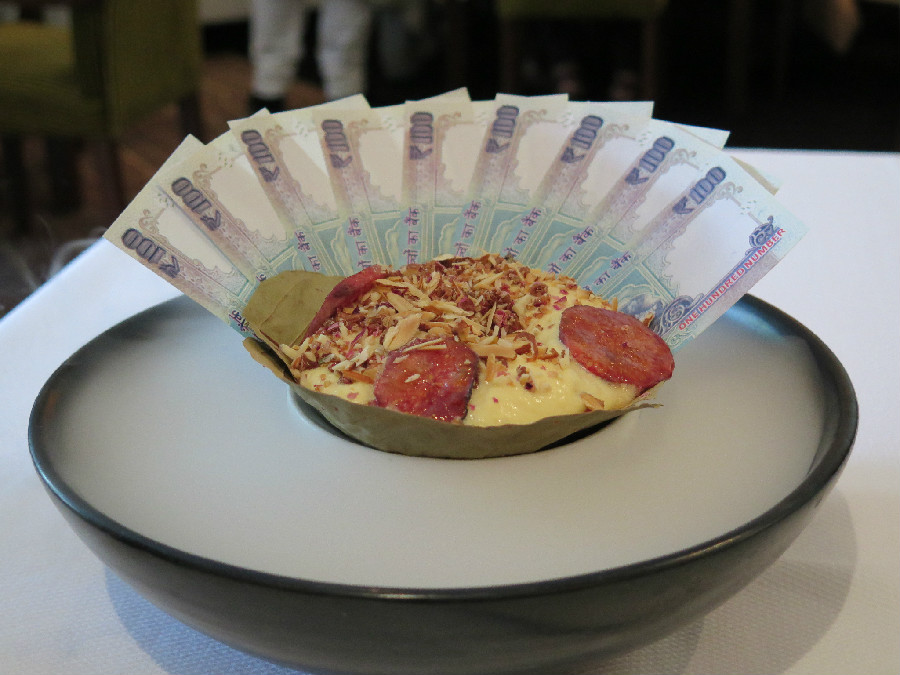
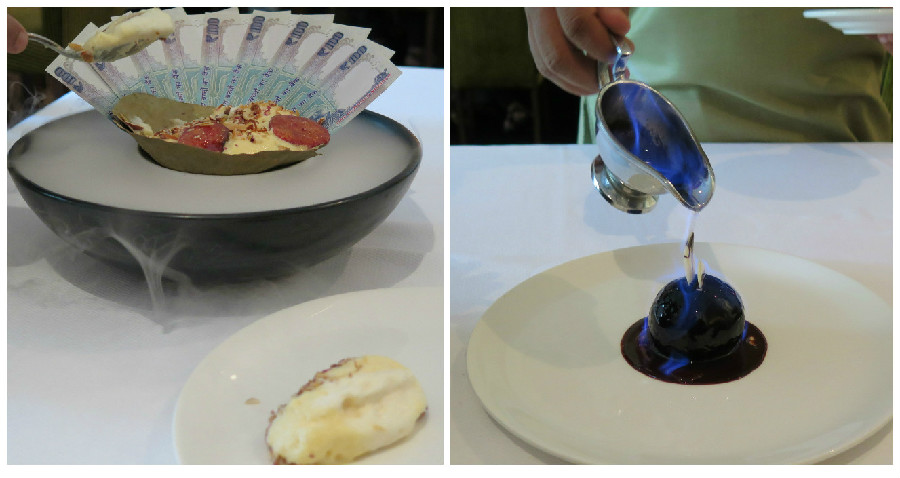
Innovation, you will find here Indian Accent doubt, but dazzling multipartite compositons which blow you away with their cooking and designer skills, were virtually absent. Even amongst the limited-component compositions, the hits were not frequent enough to register a thumping victory. Chef Manish Merhotra has accomplished a lot in terms of boldly blended modernist Indian cooking , and he is rightly hailed as the country's vanguard in this domain, but he is not pushing himself and his staff to the absolute maximum. I don't think Abhijit Saha or Vikramjeet Roy are better than him, but nor do I think vice-versa.
UPN
UPNWORLD welcomes your comments.
PS : Mr.M generously upgraded my room (I had booked in The Manor , which houses Indian Accent, for my Delhi stay) to a beautifully spacious mood-lit sanctum. Those were hot days outside and relaxing in the air-conditioned plush environs of my invitingly dark high-ceilinged room, and then leaning back into the sofa to gaze at splendid sepia pictures of Classic Delhi from a large beautiful coffee table book, ranks as one of the finer hotel-room experiences of my life.





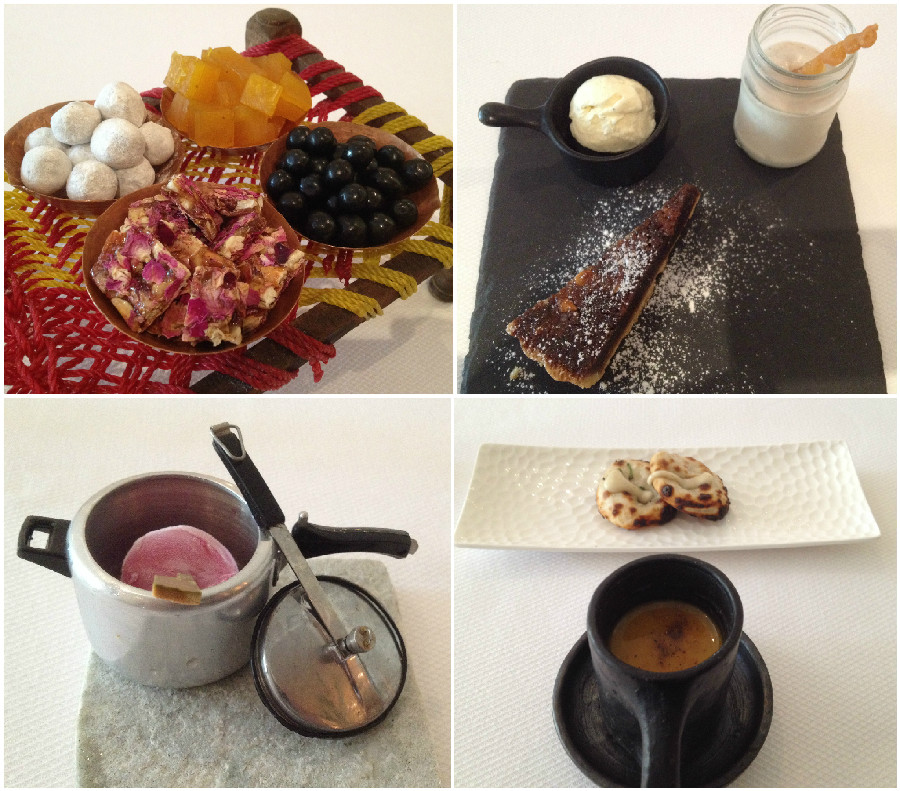
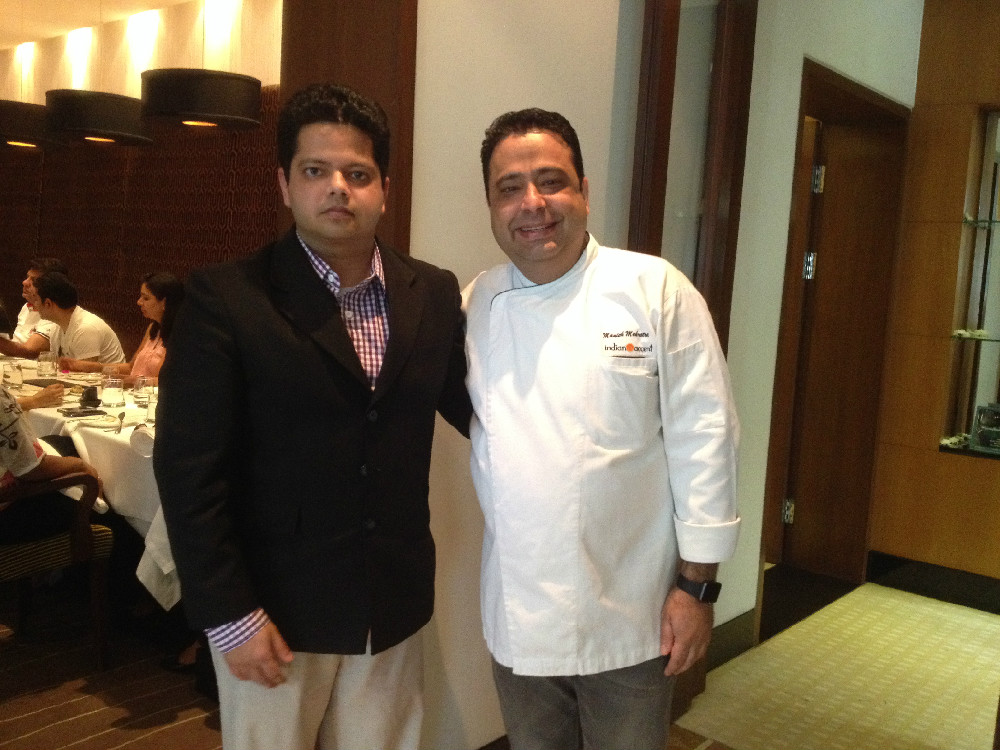















0 COMMENTS
WRITE COMMENT